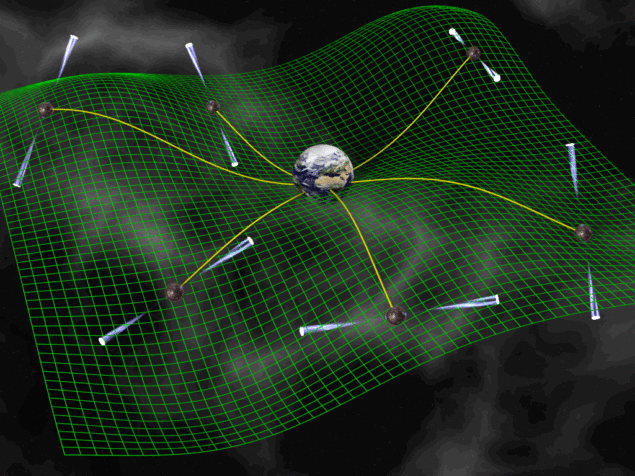
The direct detection of a gravitational wave (GW) in 2015 by the LIGO and Virgo collaborations confirmed the existence of these long sought after events. However, these and other GW events detected so far constitute only a small fraction – in the kHz regime — of the vast GW spectrum. As a result, they only probe certain phenomena such as stellar mass black-hole and neutron-star mergers. On the opposite side of the spectrum to LIGO and Virgo are Pulsar Timing Array (PTA) experiments, which search for nHz frequency GWs. Such low-frequency signals can originate from supermassive black-hole binaries (SMBHBs), while in more exotic models they can be proof of cosmic strings, phase transitions or a primordial GW background. The NANOGrav (North American Nanohertz Observatory for Gravitational Waves) collaboration has now found possible first hints of low-frequency GWs.
To detect such rumblings of space—time, which also have minute amplitudes, researchers need to track subtle movements of measurement points spread out over the size of a galaxy. For this purpose, the NANOGrav collaboration uses millisecond pulsars, several tens of which have been detected in our galaxy. Pulsars are quickly rotating neutron stars which emit cones of electromagnetic emission from their poles. When a pole points towards Earth it is detected as a short pulse of electromagnetic radiation. Not only is the frequency of millisecond pulsars high, making it easier to detect small variations in arrival time, but it is very stable over periods of many years. Combined with their great distances from Earth, this makes millisecond-pulsar emissions sensitive to any small alterations in their travel path — for example, those introduced by distortions of space–time by low-frequency gravitational waves. Such waves would cause the pulses to arrive a few nanoseconds early during January and a few nanoseconds late in June, for instance. By observing the radio emission of these objects once a week throughout many years, researchers can search for such effects.
The new results show a clear sign of a common spectrum between the studied pulsars
The problem is that GWs are not the only things which can cause a change in the arrival time of the pulses. Changes in the Earth’s atmosphere already alter the arrival time, as do changes in the position of the pulsar itself (which is usually part of a quickly rotating binary system), and the movement of Earth with respect to the source. The complexity of the measurements lies mostly in correcting for all of these effects. The latest results from NANOGrav, for example, reduce systematics by incorporating unprecedented precision (of the order of tens of km) in the orbital parameters of Jupiter.
Whereas previous results by NANOGrav and other PTA collaborations only allowed upper limits to be set on the amplitude of the GW background travelling through our galaxy, the new results show a clear sign of a common spectrum between the studied pulsars. Based on 12.5 years of data and a total of 47 pulsars studied using the ultra-sensitive Arecibo Observatory and Green Bank Telescope, the spectrum of variations in the pulsar signal arrival time was found to agree with theoretical predictions of the GW background produced by SMBHBs. The uncertainties remain large, however, which admits alternative interpretations such as cosmic strings which predict only a slightly different spectral shape. Furthermore, a key ingredient is still missing: a spatial correlation between the pulsar variations, which would confirm the quadrupole nature of GWs and provide clear proof of the nature of the signal. Finding this “smoking gun” will require longer observation times, more pulsars and smaller systematic errors — something the NANOGrav team is now working towards.
While the NANOGrav collaboration remains cautious, several exotic interpretations have already been proposed. The final sentences of their preprint summarise the status of this exciting field well: “The LIGO–Virgo discovery of high-frequency, transient GWs from stellar black-hole binaries appeared meteorically, with incontrovertible statistical significance. By contrast, the PTA discovery of very-low-frequency GWs from SMBHBs will emerge from the gradual and not always monotonic accumulation of evidence and arguments. Still, our GW vista on the unseen universe continues to get brighter”.
Further reading
NANOGrav Collab. 2020 arXiv.org:2009.04496







